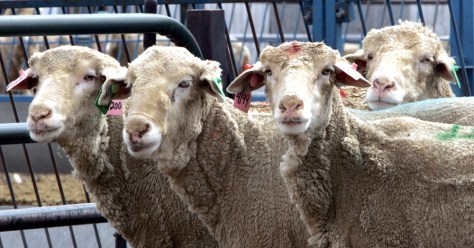RENO, Nev. — On a farm about six miles outside this gambling town, Jason Chamberlain looks over a flock of about 50 smelly sheep, many of them possessing partially human livers, hearts, brains and other organs.
The University of Nevada-Reno researcher talks matter-of-factly about his plans to euthanize one of the pregnant sheep in a nearby lab. He can’t wait to examine the effects of the human cells he had injected into the fetus’ brain about two months ago.

Sheep that have partially human livers, hearts, brains and other organs are shown here at the University of Nevada, in Sparks, Nev., on April 27.
“It’s mice on a large scale,” Chamberlain says with a shrug.
As strange as his work may sound, it falls firmly within the new ethics guidelines the influential National Academies issued this past week for stem cell research.
In fact, the Academies’ report endorses research that co-mingles human and animal tissue as vital to ensuring that experimental drugs and new tissue replacement therapies are safe for people.
Doctors have transplanted pig valves into human hearts for years, and scientists have injected human cells into lab animals for even longer.
Biological mixing of species But the biological co-mingling of animal and human is now evolving into even more exotic and unsettling mixes of species, evoking the Greek myth of the monstrous chimera, which was part lion, part goat and part serpent.
In the past two years, scientists have created pigs with human blood, fused rabbit eggs with human DNA and injected human stem cells to make paralyzed mice walk.
Particularly worrisome to some scientists are the nightmare scenarios that could arise from the mixing of brain cells: What if a human mind somehow got trapped inside a sheep’s head?
The “idea that human neuronal cells might participate in 'higher order' brain functions in a nonhuman animal, however unlikely that may be, raises concerns that need to be considered,” the academies report warned.
Mice with human brains
In January, an informal ethics committee at Stanford University endorsed a proposal to create mice with brains nearly completely made of human brain cells. Stem cell scientist Irving Weissman said his experiment could provide unparalleled insight into how the human brain develops and how degenerative brain diseases like Parkinson’s progress.
In January, an informal ethics committee at Stanford University endorsed a proposal to create mice with brains nearly completely made of human brain cells. Stem cell scientist Irving Weissman said his experiment could provide unparalleled insight into how the human brain develops and how degenerative brain diseases like Parkinson’s progress.
Stanford law professor Hank Greely, who chaired the ethics committee, said the board was satisfied that the size and shape of the mouse brain would prevent the human cells from creating any traits of humanity. Just in case, Greely said, the committee recommended closely monitoring the mice’s behavior and immediately killing any that display human-like behavior.

The Academies’ report recommends that each institution involved in stem cell research create a formal, standing committee to specifically oversee the work, including experiments that mix human and animal cells.
Weissman, who has already created mice with 1 percent human brain cells, said he has no immediate plans to make mostly human mouse brains, but wanted to get ethical clearance in any case. A formal Stanford committee that oversees research at the university would also need to authorize the experiment.
Harvesting human organs from sheep Few human-animal hybrids are as advanced as the sheep created by another stem cell scientist, Esmail Zanjani, and his team at the University of Nevada-Reno. They want to one day turn sheep into living factories for human organs and tissues and along the way create cutting-edge lab animals to more effectively test experimental drugs.
Zanjani is most optimistic about the sheep that grow partially human livers after human stem cells are injected into them while they are still in the womb. Most of the adult sheep in his experiment contain about 10 percent human liver cells, though a few have as much as 40 percent, Zanjani said.
Because the human liver regenerates, the research raises the possibility of transplanting partial organs into people whose livers are failing.
Zanjani must first ensure no animal diseases would be passed on to patients. He also must find an efficient way to completely separate the human and sheep cells, a tough task because the human cells aren’t clumped together but are rather spread throughout the sheep’s liver.
Zanjani and other stem cell scientists defend their research and insist they aren’t creating monsters — or anything remotely human.
Read all:
As in the days of Noah!
ReplyDeleteAmen!
ReplyDeletehow sick is this - frankenanimals //
ReplyDeleteThis is crazy!!!!people are sick and blind!!! The bible Gods word has warned us of these things...
ReplyDeleteAll I know is if one of your kids needs a heart or liver you wouldn't give a rats ass if it was grown in a sheep. You would thank God for it. As would I. But we all know that will never happen because most of us are not of the chosen.
ReplyDelete